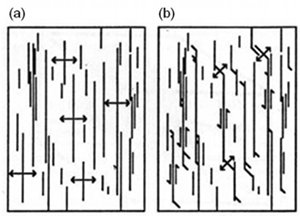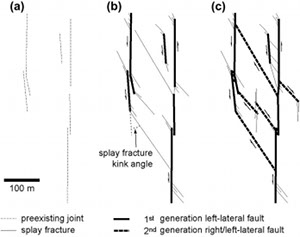| |||||||
|
|
|||||||
|
|
|||||||
| Mechanisms and Mechanics of Non-orthogonal Systems | |||||||
|
Using the definition that joints form along the principal planes perpendicular to the greatest tension or the least compression (Figure 1a), non-orthogonal joint sets represent different stress states. It follows that the older set (the first set) must have been subjected to some shearing as depicted in the schematic diagram in Figure 1b. Sometimes the so-called splay joints (the second set) are subsequently sheared also forming another set of splay joints (third set) which may or may not be in the orientation of the first set. These have been documented in great detail in various kinds of faulting environments as illustrated in Figure 2 and Figure 3 (Davatzes and Aydin, 2003; Myers and Aydin, 2004; Flodin and Aydin, 2004). It turns out that the underlying basic mechanism of this process is the formation of splay joints by shearing of an initial flaw including a joint or a joint set. Please see 'Mechanisms and Mechanics of Splay Joints' for more details. Rawnsley et al. (1992; 1997), Bourne and Williams (2001), Kattenhorn et al. (2000), and Maerten et al. (2006) have simulated joint formations associated with faults in an elastic stress field. Figure 4 shows a 3D pattern of a joint network induced by local stresses associated with a system of strike-slip faults at Bristol Channel (UK). The basic premise is that the joints in an elastic stress field around a network of strike-slip faults propagate along the principal stress trajectory corresponding to that perpendicular to the greatest tension or the least compression. Here, more complex joint patterns occur near the intersections of the faults. It is also clear that the shorter faults between continuous systematic sets occur in a splay orientation with respect to the latter (see de Joussineau et al., 2007 for the so-called kink-angle distribution) suggesting that they formed as splay joints prior to their shearing. | |||||||
| Reference: |
|||||||
| Bourne, S.J., Willemse, E.J.M, 2001 Davatzes, N.C., Aydin, A., 2003 de Joussineau, G., Mutlu, O., Aydin, A., Pollard, D.D., 2007 Flodin, E.A., Aydin, A., 2004 Kattenhorn, S., Aydin, A., Pollard, D.D., 2000 Maerten, L., Gillespie, P.A., Daniel, J.M., 2006 Myers, R., Aydin, A., 2004 Rawnsley, K.D., Rives, T., Hencher, S.R., Lumsden, A.C., 1992 Rawnsley, K.D., Auzias, V., Petit, J.P., Rives, T., 1997 |
|||||||
|
Readme | About Us | Acknowledgement | How to Cite | Terms of Use | Ⓒ Rock Fracture Knowledgebase |
|||||||



